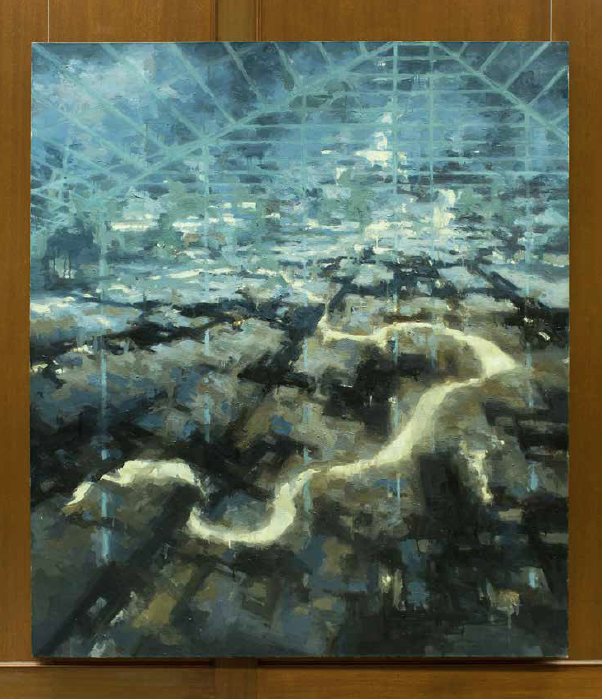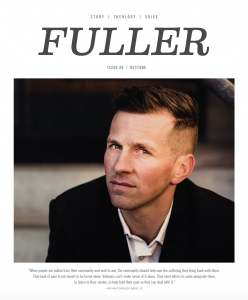From Mark Labberton, President
The Northern California reservoir had been virtually empty for years. The underbrush had long been dry or dead. Trees that once flexed fluidly in the wind were shrinking down into themselves, with branches and bark cracked and broken. It was a landscape dying to be restored.
Without imagination or hope, the powdery earth waited for the scarce, variable, miraculous gift of water. Then the rains came. That same landscape shocked into ferocious life. Harsh stubble became verdant. Barren branches, fecund. The scrabbled earth awoke.
The long-awaited gift of moisture changed even the air we breathed, and the spring that sprung was fresh and vivid and gratefully received. It was spring of 2016 when the ground of Northern California was restored and everything—and everyone—bore thankful witness. Whether it was enough to stem the drought remains to be seen, but in the meantime the hills, the wildflowers, and the reservoirs give evidence of hope.
Restoration is a grace, like something returned that we thought lost forever, exceeding what we might imagine or hope. When something has been restored, it is more than merely repaired or returned: it is a cause for wonder.
Some occasions allow us to lend a hand at restoration: we might restore an old car or a decaying house or a piece of furniture. We can work at putting the pieces of our lives back together when we have suffered personal adversity or despair. We can yield to the efforts of others or initiate those efforts ourselves. But when restoration occurs, the transformation brings with it a sense of wonder—a patina that we know we did not create, that is different than the shine of something new. It can be better, deeper, richer.
The most delicate restoration is human and interpersonal. Drought, decay, and damage to the human spirit can occur in any setting where humans live: in friendship, marriage, work. It’s not always easy to recognize loss or places where restoration might be needed partly because we rely on inadequate memory to reconstruct the why, the who, and the when of our losses. This makes things difficult, as one of my Fuller psychology professors said years ago, because “things aren’t like they used to be . . . and they never were.” Our chances of restoration are thus likely to be threatened by faulty memories, making it impossible to restore “what never was.”
Restoration bears its own marks, like the glueline on a vase that was broken and restored. This restoration line can be a badge of honor: a mark of maturity, of value, of attentive care— even love. People bear these glue-lines, too. Often even without hearing a person’s story, one can detect glue-lines in the depth of their eyes or in some nuance of speech. Glue-lines may be intriguing, but can also make us apprehensive and vulnerable. Much of the time restoration is complicating and difficult even while it is wonderfully real. The woman at the well was restored by Jesus and sent back to her town with a new and radically different story. She was the recipient of a grace that drew many, but was also complicating for everyone. The man born blind whom Jesus healed had the hardest time with his own parents who, as a result, were put in an awkward situation with religious authorities. The glue-line could not have been more obvious to them, and yet they hesitated: “We know he is our son and we know he was born blind, but how he can now see, or who opened his eyes, we don’t know.” It was easier and safer to avoid mention of the miraculous restoration than to name it.
Restored earth, restored relationships, restored identity: these are among God’s gracious works of love and renewal. Since the resurrected Lord retains the marks of the cross, we know that God identifies with both human brokenness and grace that comes outside of merely human solutions. In Fuller’s exploration of what it means to “restore,” we bear witness to our need and to God’s transcendence—to the human landscape we occupy that is dying to be restored and the wonderment of the grace for which we wait.

Intermediary, says artist Greg King, is part of a series of paintings “where the surface of the earth is viewed as a sacred collaboration: the grids of farms, wires, and roads reworked by elemental downpours of fire and light, oil paint and atoms. The river nourishes as it wrenches the man-made order of things, guides as it cuts through, enriches as it disrupts.” King is an artist and award-winning filmmaker based in Los Angeles who holds an MFA from Hunter College, and has exhibited his artwork and films widely.
+ Intermediary by Gregory King, oil on canvas, 78″ x 63″, facebook.com/gregkingartist
Restauración, maravilla y la línea de pegamento
La reserva del Norte de California ha estado virtualmente vacía por años. La maleza ha estado seca o muerta por mucho tiempo. Los árboles que alguna vez se flexionaban con fluidez en el viento se encogían hacia ellos mismos, con las ramas y cortezas agrietadas y rotas. Era un paisaje que moría por ser restaurado.
Sin imaginación o esperanza, la tierra polvorienta esperaba por el escaso, variable, milagroso regalo del agua. Y entonces, las lluvias vinieron. Ese mismo paisaje se conmocionó a una vida feroz. Los duros restrojos se volvieron verdes. Ramas estériles, fecundan. La tierra revuelta despertó.
El tan esperado regalo de la humedad cambió hasta el aire que respiramos y la primavera que surgió era fresca y vívida y recibida con gratitud. Era la primavera del 2016 cuando el suelo del Norte de California fue restaurado y todo — y toda persona — dieron un testimonio de agradecimiento. Si ha sido suficiente para detener la sequía está por verse, pero mientras tanto las colinas, las flores silvestres y las reservas muestran evidencia de esperanza.
La restauración es una gracia, como algo devuelto que pensábamos haber perdido para siempre, que sobrepasa lo que podemos haber imaginado o esperado. Cuando algo ha sido restaurado, es más que ser simplemente reparado o devuelto: es un motivo para maravillarse.
Algunas ocasiones nos permiten ayudar en la restauración: podemos restaurar un auto viejo o una casa deteriorada o un mueble. Podemos esforzarnos en unir las piezas de nuestra vida cuando sufrimos desesperación o una adversidad personal. Podemos inclinarnos hacia los esfuerzos de otras personas o iniciar esos esfuerzos por nuestra cuenta. Pero cuando la restauración ocurre, la transformación trae consigo un sentido de maravilla — una pátina que sabemos que no creamos, que es diferente al brillo de algo nuevo. Puede ser mejor, más profundo y más rico.
La restauración más delicada es la humana e interpersonal. Sequía, decadencia y daño al espíritu humano pueden ocurrir en cualquier lugar donde vivan los seres humanos: en la amistad, el matrimonio, el trabajo. No siempre es fácil reconocer la pérdida o lugares donde se necesite la restauración, en parte porque dependemos de una memoria inadecuada para reconstruir el por qué, el quién y el cuándo de nuestras pérdidas. Esto hace que las cosas sean difíciles, como uno de mis profesores de sicología de Fuller dijo hace años, porque “las cosas nunca son como solían ser… y nunca fueron.” Por eso nuestras oportunidades de restauración pueden ser amenazadas por memorias defectuosas, haciendo imposible restaurar “lo que nunca fue.”
La restauración lleva sus propias marcas, como la línea de pegamento en un florero que fue restaurado. Esta línea de restauración puede ser una insignia de honor, una marca de madurez, de valor, de atento cuidado – incluso amor. Las personas también llevan estas líneas de pegamento. A veces aún sin escuchar la historia de la persona, se pueden detectar las líneas de pegamento en lo profundo de sus ojos o en algún matiz de expresión. Las líneas de pegamento pueden ser intrigantes, pero también nos pueden hacer vulnerables y causar temor. La mayoría del tiempo la restauración es complicada y difícil, aún cuando es maravillosamente real. La mujer samaritana fue restaurada por Jesús y enviada devuelta a su pueblo con una historia nueva y radicalmente diferente. Ella fue la recipiente de una gracia que atrajo a muchas personas, pero que también se complica para todo el mundo. El hombre que nació ciego, a quien Jesús sanó, tuvo el tiempo más difícil con sus padres quienes, como resultado, quedaron en una posición incómoda con las autoridades religiosas. Las líneas de pegamento no les podían ser mas obvias, más sin embargo titubearon: “Sabemos que es nuestro hijo y sabemos que nació ciego, pero cómo es que ahora puede ver, o quién abrió sus ojos, no sabemos.” Era más fácil y seguro evitar mencionar la restauración milagrosa que llamarla por su nombre.
La tierra restaurada, relaciones restauradas, identidad restaurada: éstas están en medio del trabajo misericordioso de amor y renovación de Dios. Como el Señor resucitado retiene las marcas de la cruz, sabemos que Dios se identifica tanto con el quebrantamiento humano como con la gracia que sale de soluciones meramente humanas. En la exploración de Fuller de lo que significa “restaurar,” damos testimonio de nuestra necesidad y de la trascendencia de Dios – al paisaje humano que ocupamos que está muriendo por ser restaurado y la maravilla de la gracia que esperamos.

Intermediary, says artist Greg King, is part of a series of paintings “where the surface of the earth is viewed as a sacred collaboration: the grids of farms, wires, and roads reworked by elemental downpours of fire and light, oil paint and atoms. The river nourishes as it wrenches the man-made order of things, guides as it cuts through, enriches as it disrupts.” King is an artist and award-winning filmmaker based in Los Angeles who holds an MFA from Hunter College, and has exhibited his artwork and films widely.
+ Intermediary by Gregory King, oil on canvas, 78″ x 63″, facebook.com/gregkingartist
회복, 경이로움, 이음새
북부 캘리포니아의 저수지는 수년간 거의 텅 비어 있었습니다. 나무 아래 덤불은 오랫동안 메마르거나 죽어 있었습니다. 한때 바람에 풍성하게 흔들리던 나무는 가지와 질이 갈라지고 부러진 채 쓸쓸히 움츠러들고 있었습니다. 그것은 회복을 처절히 갈망 며 죽어가는 풍경이었습니다.
실낱같은 기대도 희망도 없이 그 푸석푸석한 대지는 드문드문 변덕스럽게 기적적으로 찾아오는 선물인 물을 기다렸습니다. 바로 그때 우기가 도래했습니다. 조금 전까지 죽은듯했던 그 풍경은 소스라치며 맹렬한 생기를 띠었습니다. 황량했던 그루터기가 릇푸릇해지고, 메말랐던 가지는 충실해졌습니다. 가뭄에 할퀴어진 대지가 깨어났습니다.
오래 기다렸던 선물인 수분은 우리가 숨 쉬는 대기마저 바꿔놓았고 사람들은 불쑥 찾아온 생동하는 신선한 봄을 감사로 맞이했습니다. 그렇게 2016년 봄에 북부 캘리포니아의 대지는 회복되었고 만물과 모든 이는 감사를 고백했습니다. 가뭄을 이겨내기에 충분했는지는 지켜볼 일이지만, 그 사이 언덕과 들꽃과 저수지는 희망을 여실히 드러내고 있습니다.
회복은 은혜입니다. 영영 잃어버렸다고 생각한 무언가를 되찾을 때처럼 회복은 우리의 상상과 희망을 초월하기 때문입니다. 무언가가 회복되었을 때, 그것은 단순히 수리되거나 돌려받은 것 이상의 경이로움을 불러일으킵니다.
이따금 우리는 낡은 자동차나 무너져가는 집이나 가구를 복원할 때처럼 회복에 참여하게될 기회가 있습니다. 개인적인 재난이나 낙심되는 일을 겪었을 때는 삶의 조각들을 다시 붙여보려고 애쓰기도 합니다. 다른 누군가의 노력에 자신을 맡기기도 하고 우리 스스로 그런 노력을 시작하기도 합니다. 하지만 일단 회복이 일어나게 되면, 그때 찾아오는 변화는 어떤 경이로운 느낌을 동반합니다. 분명 우리가 만들지 않은 그 고색창연한 빛깔, 그것은 새것이 주는 반짝임과는 다릅니다. 회복은 더 좋고, 더 깊고, 더 풍부할 수 있습니다.
가장 절묘한 회복은 사람에게, 사람 사이에 일어납니다. 살다 보면 친구, 결혼, 직장 등 모든 상황에서 우리 영혼에 가뭄, 무너짐, 상처 등이 생길 수 있습니다. 그럴 때 상실, 즉 회복이 필요한 영역을 알아차리는 것은 그리 쉬운 일만은 아닙니다. 부분적으로 그 이유는 우리가 상실의 이유, 시기, 관련인을 재구성할 때 불완전한 기억에 의존하기 때문입니다. 오래전 저를 가르치셨던 풀러의 심리학 교수님 한 분이 이런 말씀을 하셨습니다. “세상은 더 이상 예전 같지 않습니다… 그랬던 적이 없으니까요.” 바로 이것이 일을 어렵게 만듭니다. ‘그랬던 적이 없는 것’을 복원할 수는 없기에, 불완전한 기억은 회복이 우리에게 일 나는 것을 더욱 어렵게 만듭니다.
깨어졌다 복원된 꽃병에 생긴 이음새처럼, 회복은 고유한 흔적을 남깁니다. 회복이 남긴 자국은 마치 명예로운 휘장처럼 우리의 원숙함, 가치, 세심한 관심, 그리고 무엇보다 사랑을 돋보이게 할 수 있습니다. 종종 우리는 누군가의 사연을 듣기도 전에 그의 깊은 눈매나 미묘한 어투에서 이음새를 발견하기도 합니다. 이음새는 매력적일 수 있지만, 반대로 우리를 불안하거나 쉽게 상처받도록 만들기도 합니다. 많은 경우 회복은 경이로운 현실임에도 불구하고 우리를 복잡하고 곤란한 상황으로 몰고 갑니다. 예수님은 우물가의 그 여인을 회복시키신 뒤에 전혀 다른 새 이야기를 주시며 마을로 돌려 보내셨습니다. 그는 은혜의 수혜자였고 많은 사람이 거기에 이끌렸지만, 동시에 모든 이에게 복잡한 질문을 안겨주었습니다. 맹인으로 태어나 예수님께 치유 받은 남자는 부모님과 어느 때보다도 힘든 시간을 보내야 했는데, 치유 사건이 그의 부모를 종교 권력자들과의 불편한 상황으로 몰아넣었기 때문입니다. 그의 부모에게 이음매는 더할 나위 없이 뚜렷했지만, 그들은 주저했습니다. “이 사람이 우리 아들인 것과 맹인으로 난 것을 아나이다. 그러나 지금 어떻게 해서 보는지 또는 누가 그 눈을 뜨게 하였는지 우리는 알지 못하나이다.” 그 기적적인 회복은 거론하는 것보다 언급을 회피하는
쪽이 쉽고 안전했습니다.
회복된 대지, 회복된 관계, 회복된 정체성, 이런 것들은 사랑과 소생이라는 하나님의 은혜로우신 사역에 포함됩니다. 부활하신 주님께서 여전히 십자가의 흔적을 지니고 계신다는 사실은 인간의 깨어짐, 그리고 보잘것없는 인간의 해법을 초월하는 은혜, 이 두 가지가 모두 하나님께는 이질적이지 않음을 말해줍니다. 풀러가 ‘회복’의 의미를 찾아가는 이 시점에, 처절하게 회복을 갈망하는 이 땅의 풍경과 우리가 기다리는 경 로운 은혜를 되새기며 우리의 가난함과 하나님의 초월하심을 고백합니다.

Intermediary, says artist Greg King, is part of a series of paintings “where the surface of the earth is viewed as a sacred collaboration: the grids of farms, wires, and roads reworked by elemental downpours of fire and light, oil paint and atoms. The river nourishes as it wrenches the man-made order of things, guides as it cuts through, enriches as it disrupts.” King is an artist and award-winning filmmaker based in Los Angeles who holds an MFA from Hunter College, and has exhibited his artwork and films widely.
+ Intermediary by Gregory King, oil on canvas, 78″ x 63″, facebook.com/gregkingartist


